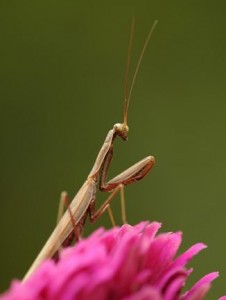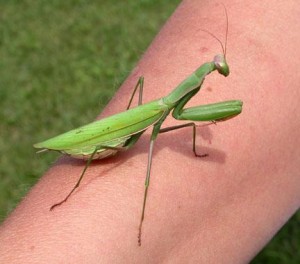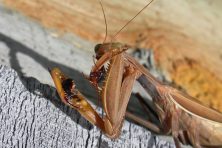Praying Mantis: The Earthly ET
- Share
- Tweet
- Pin
- Share
An enriching treat, in the form of a rather unusual insect, could very well have been my reward yesterday as I neared the completion of a physically demanding outdoor stair-building project winding itself up the east slope next to our house.
A two-inch-long tan Praying Mantis surprised me as I moved a wooden marking stick to which it was clinging. Naturally its welcome appearance signaled picture-taking time.
Charlotte served as a very patient assistant, allowing the mantis to harmlessly crawl up and down her arm and onto her back. Finally when the long-legged creature headed up the back of her neck and onto her hair, tickling her in the process, it was time to transfer it to one of the front yard Zinnias. There it posed statue-like for image after image. Fortunately it remained on the same flower during the night and until noon today.
The identifying feature of the European Mantid (or Mantis) is the black-ringed white spot, easily observed beneath each of its fore coxae (COK-see), the parts of the front legs nearest the thorax. These legs are heavily armored with spines and teeth and can move with great speed to capture its prey. That includes many kinds of insects regarded by people to be helpful in some cases and harmful in others. The mantids don’t choose, they simply catch and eat!
The first Praying Mantis I had the pleasure of seeing in Door County was captured by an alert person at the Sister Bay Yacht Club and Resort in the fall of 1988. Eventually, over the past 21 years, reports of these predatory insects have become fairly common and widespread at least in northern Door County. There have been some autumn seasons when I could count upwards of a dozen of their egg masses attached to various parts of our garden shed, especially on the underside of the roof soffit.
A completed inch-long egg case is shaped like a short broad cornucopia of dried foam. At first it is moist, shiny and sticky but soon dries and hardens. The eggs overwinter and hatch almost simultaneously the following spring. I had the good fortune a few years ago in late September of watching and photographing the entire egg-laying process taking place on a foot-tall wooden mushroom that stands next to our front door. The abdomen of that gravid (heavy with eggs) female was unusually large and I estimated her body length to be close to three inches.
What really developed my initial interest in the Praying Mantis was an intriguing and fascinating chapter, “Dinah Was A Mantis” that I read in Edwin Way Teale’s great book Near Horizons, The Story of an Insect Garden, published by Robert Hale Limited (London) in 1947. Do your best to borrow or obtain a copy of this excellent book written by one of my all-time favorite nature writers. You won’t be sorry!
It was this story that prompted me to purchase from biological supply businesses through the years Praying Mantis egg cases, which added great interest, especially after the eggs hatched, to some of my science classes. As soon as the students discovered the tiny newly hatched Mantids to be cannibalistic, those students wished they could take one or more of the insects home and attempt to raise them in captivity. Several succeeded in doing so. One of the creatures always was allowed to remain in a glass terrarium in the classroom where it was fed fruit flies or other small insects and bits of hamburger dangled in front of the Mantid on a piece of thread.
Had the movie ET been produced when my students and I were having the times of our lives with the pet Mantis perhaps they too would have nicknamed it “ET” as Charlotte and I did in the following years. The triangular-shaped head, which the insect can move around, and large compound eyes of the Praying Mantis immediately reminded us of the lovable ET of movie fame.
Only one species of Mantid, of the roughly 1,800 worldwide, is native to the U.S., the Carolina Mantid. The only Mantids fairly common in parts of the northern states are two introduced species, the European or Praying Mantis, around two to three inches long, and the Chinese Mantid, about four inches long.
The Mantid’s very strong mouth parts are capable of biting through the quite hard plastic-like chitinous (KY-ti-nus) exoskeletons of insects such as beetles and wasps. The long middle and hind legs give the Praying Mantis the ability to remain motionless for many minutes at a time, its front legs “raised in prayer” as it patiently waits for its prey insects to unsuspectingly crawl or land near the perpetually hungry Mantis. Obviously its praying-like attitude is reflected in the “religiosa” species name of the Praying Mantis. In light of the Praying Mantis’ amazing front leg speed in seizing its prey, the Mantis is otherwise a slow moving insect. The winged adults’ flight is short and labored.
What a thing of beauty to see a Mantid slowly turn its head and watch your every movement as though thoroughly captivated. I wonder whether the mantis is the only insect able to turn its head and look over its shoulder like a human. There is little wonder that “ET” is such as enchanting creature.
Everyone should have at least one pet Praying Mantis in their life, an Emotional Thrill, an Enriching Treat, a form of Educational Therapy at its best, a genuine “ET” to top them all.




